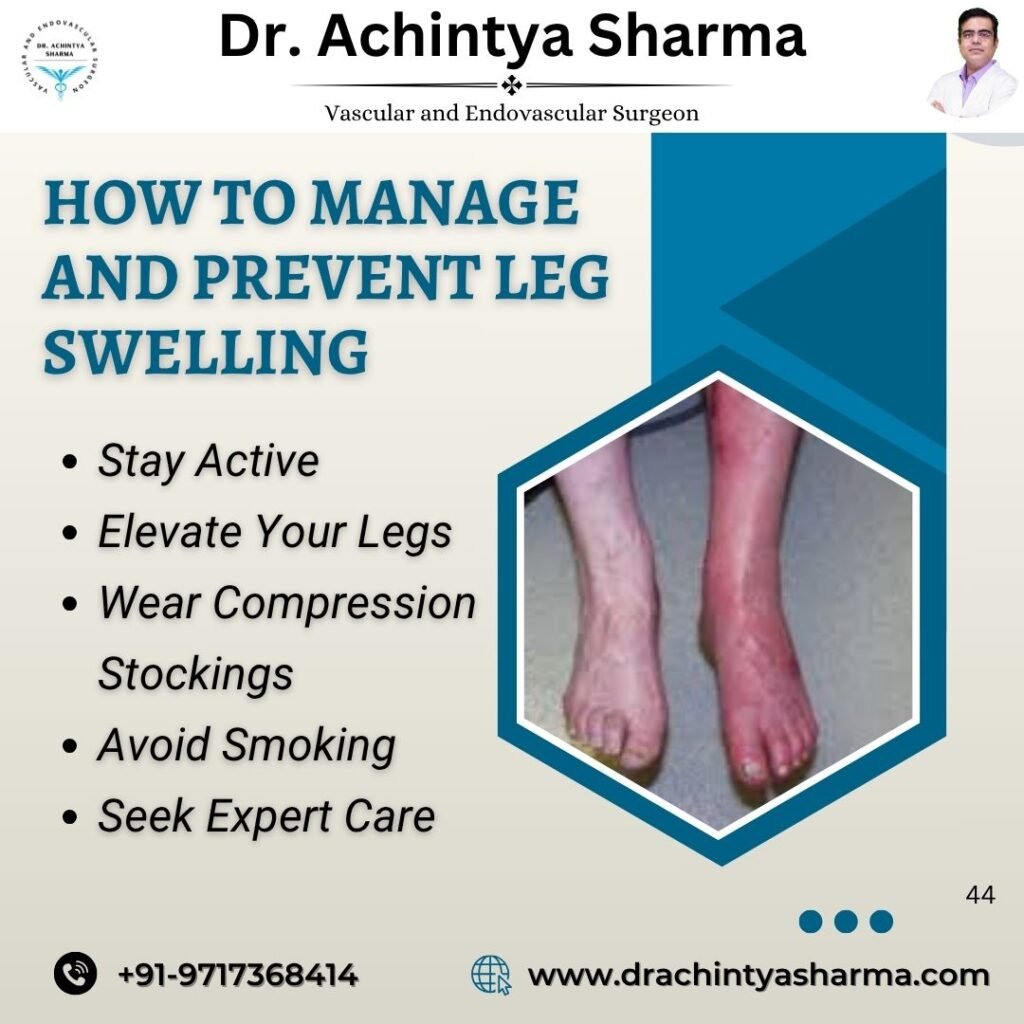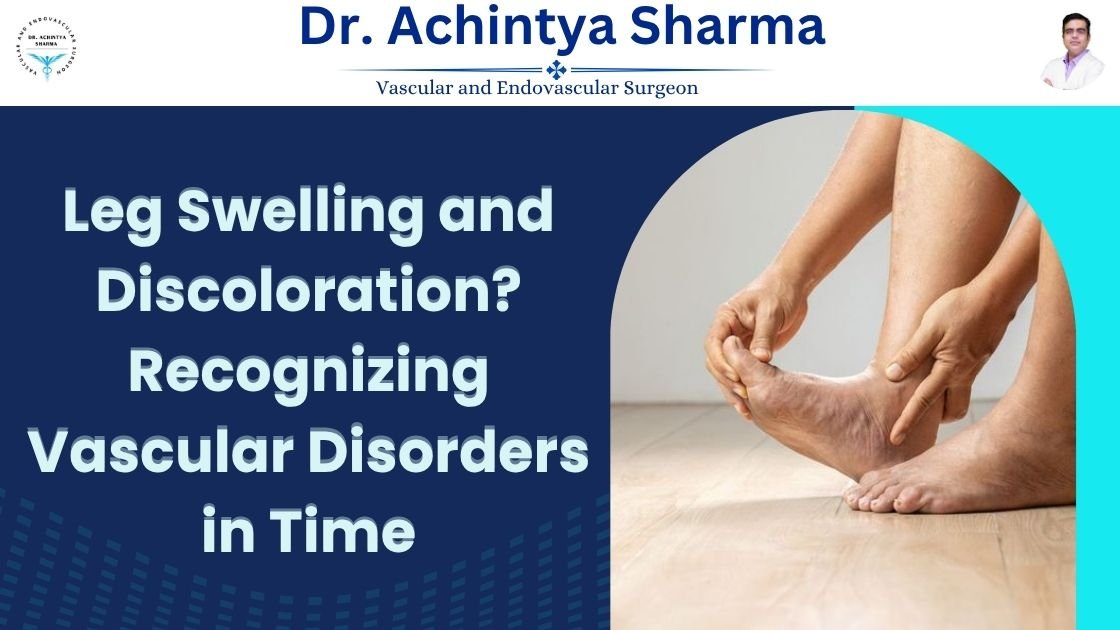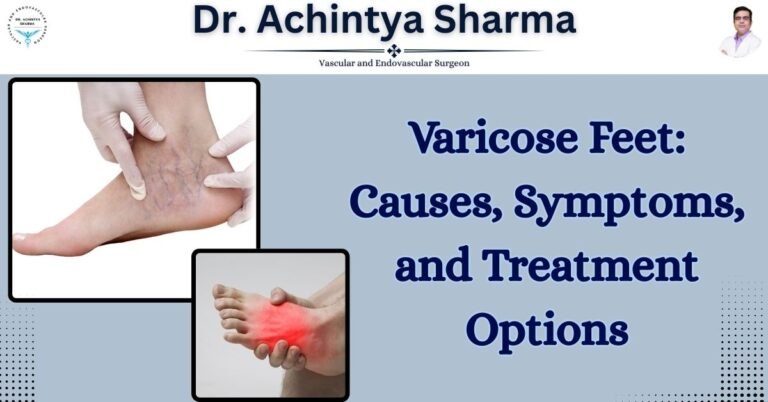Have you ever noticed your leg swelling after standing or sitting for long hours? While it may seem harmless at first, swelling or discoloration in the legs can often be a sign of an underlying vascular disorder. These changes happen when blood or fluid builds up in your tissues due to poor circulation. Ignoring the signs can lead to serious complications if left untreated. According to Dr. Achintya Sharma, a leading vascular specialist, leg is swelling should never be overlooked — it’s your body’s way of alerting you that something’s wrong. Let’s understand what causes it and how early diagnosis can help protect your health.
Why You Shouldn’t Ignore Leg Swelling
Leg swelling is more than just discomfort — it’s a potential warning sign. Many people assume it’s caused by standing too long or walking too much, but swelling that persists or worsens could mean poor vein function or circulation problems.
When veins fail to return blood efficiently to the heart, fluid begins to collect in the lower legs, ankles, or feet. Over time, this can lead to pain, heaviness, and skin discoloration.
What Causes Leg Swelling and Discoloration?
To understand leg is swelling, it helps to know how your veins work. Veins carry blood back to your heart, and tiny valves inside them prevent backflow. When these valves become weak or damaged, blood begins to pool in your legs, leading to swelling and heaviness.
Here are some of the most common causes of leg swelling and discoloration:
1. Chronic Venous Insufficiency (CVI)
This is one of the leading causes of swelling. It happens when vein valves don’t function properly, causing blood to flow backward and pool in the legs. Symptoms include aching, heaviness, and dark patches on the skin.
2. Deep Vein Thrombosis (DVT)
A blood clot forming in a deep vein can block blood flow, causing one leg to swell suddenly. It’s a serious medical emergency, as clots can travel to the lungs and cause pulmonary embolism.
3. Lymphedema
When the lymphatic system becomes damaged or blocked, fluid accumulates in the tissues. This condition often causes persistent leg swelling and thickening of the skin.
4. Infection or Injury
Cellulitis, trauma, or muscle strain can also trigger localized swelling, redness, or pain in one leg.
5. Heart, Kidney, or Liver Problems
Fluid retention from underlying organ conditions can cause both legs to swell, especially around the ankles.
How to Manage and Prevent Leg Swelling
The good news? Most causes of leg swelling can be managed effectively with timely treatment and lifestyle adjustments. Here’s what you can do:
1. Stay Active
Movement keeps blood flowing. Try walking, stretching, or doing light leg exercises daily. Avoid sitting or standing in one position for long hours.
2. Elevate Your Legs

Lift your legs above heart level for 15–20 minutes a few times a day. This helps reduce swelling and improve blood circulation.
3. Wear Compression Stockings
Compression stockings support your veins and prevent fluid from collecting in your legs. Dr. Achintya Sharma recommends them for people prone to chronic swelling or varicose veins.
4. Maintain a Healthy Weight
Extra weight puts pressure on your veins, worsening swelling. A balanced diet and regular exercise can make a big difference.
5. Avoid Smoking and Alcohol
Both habits damage blood vessels and slow circulation. Quitting them lowers your risk of developing vascular disorders.
6. Seek Expert Care
If swelling persists for more than a few days or is accompanied by redness, pain, or discoloration, see a vascular specialist like Dr. Achintya Sharma. Early treatment can prevent complications such as ulcers or clots.
When to See a Doctor
You should seek immediate medical attention if your leg is swelling:
- Occurs suddenly and in one leg only
- Is accompanied by pain, redness, or warmth
- Is associated with shortness of breath or chest pain (could indicate a clot)
- Leads to changes in skin color or texture
- Doesn’t improve with rest or elevation
FAQs
1. What causes leg swelling?
It’s often caused by poor circulation, venous insufficiency, blood clots, or fluid buildup due to heart, liver, or kidney issues.
2. Is it always serious??
Not always, but persistent or painful swelling may indicate a vascular condition that needs medical attention.
3. Can it be treated at home?
Mild cases can improve with rest, elevation, and compression stockings, but chronic swelling needs professional care.
4. When should I see Dr. Achintya Sharma?
If your swelling doesn’t subside in a few days or you notice redness, pain, or skin changes, consult Dr. Achintya Sharma immediately.
Conclusion
Leg swelling and discoloration are your body’s way of signaling that something isn’t right. Ignoring these signs can allow vascular conditions to worsen silently. With timely diagnosis, expert care, and simple lifestyle changes, you can prevent complications and restore your leg health. Dr. Achintya Sharma, an experienced vascular specialist, stresses the importance of early action and awareness. Remember, healthy veins mean healthy legs — don’t wait for discomfort to turn into danger. Take charge of your vascular health today and protect your legs for a more active, pain-free tomorrow.




